Leading Lean Projects Question and Answer 2022
VerifiedAdded on 2022/09/29
|17
|4734
|19
AI Summary
Contribute Materials
Your contribution can guide someone’s learning journey. Share your
documents today.
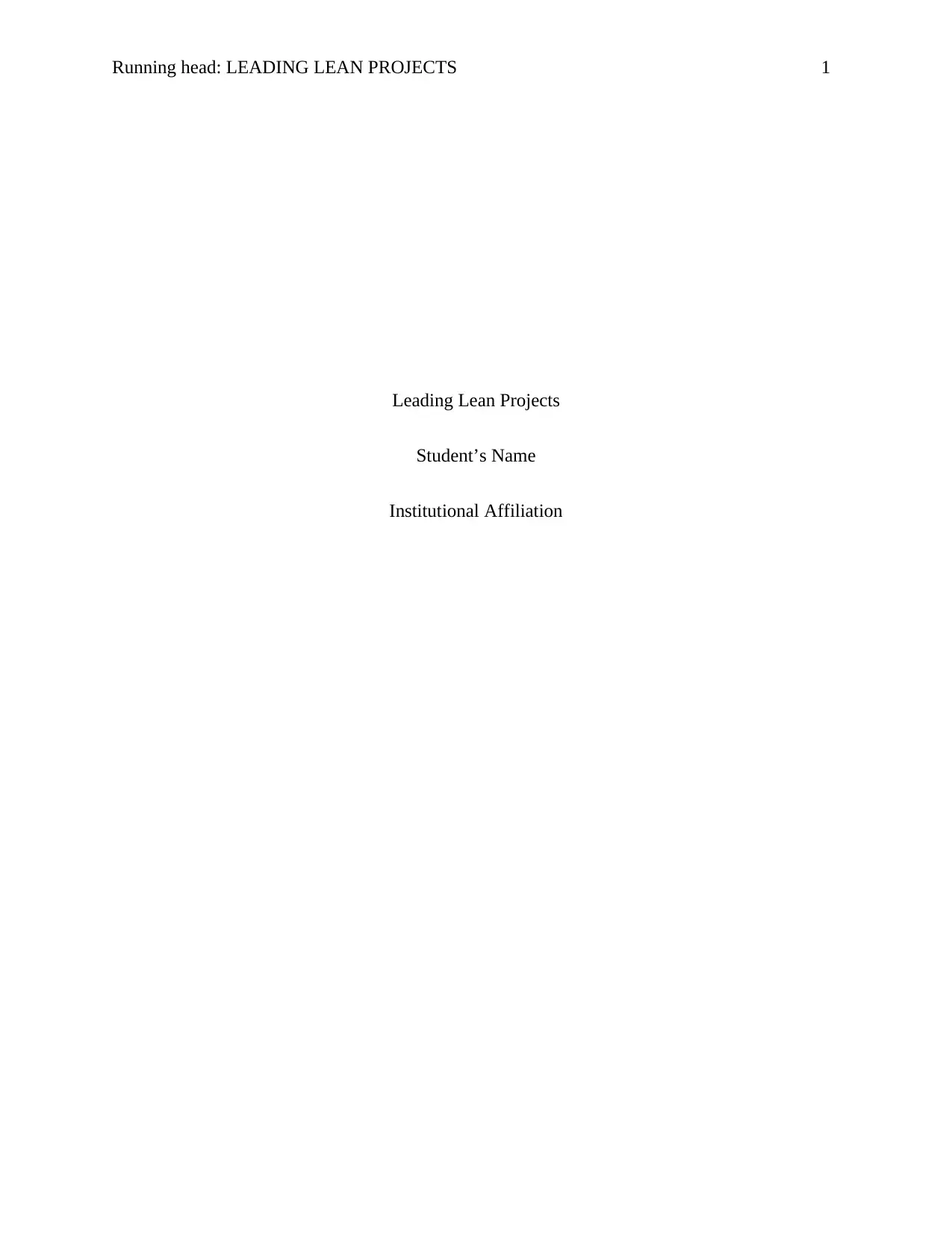
Running head: LEADING LEAN PROJECTS 1
Leading Lean Projects
Student’s Name
Institutional Affiliation
Leading Lean Projects
Student’s Name
Institutional Affiliation
Secure Best Marks with AI Grader
Need help grading? Try our AI Grader for instant feedback on your assignments.
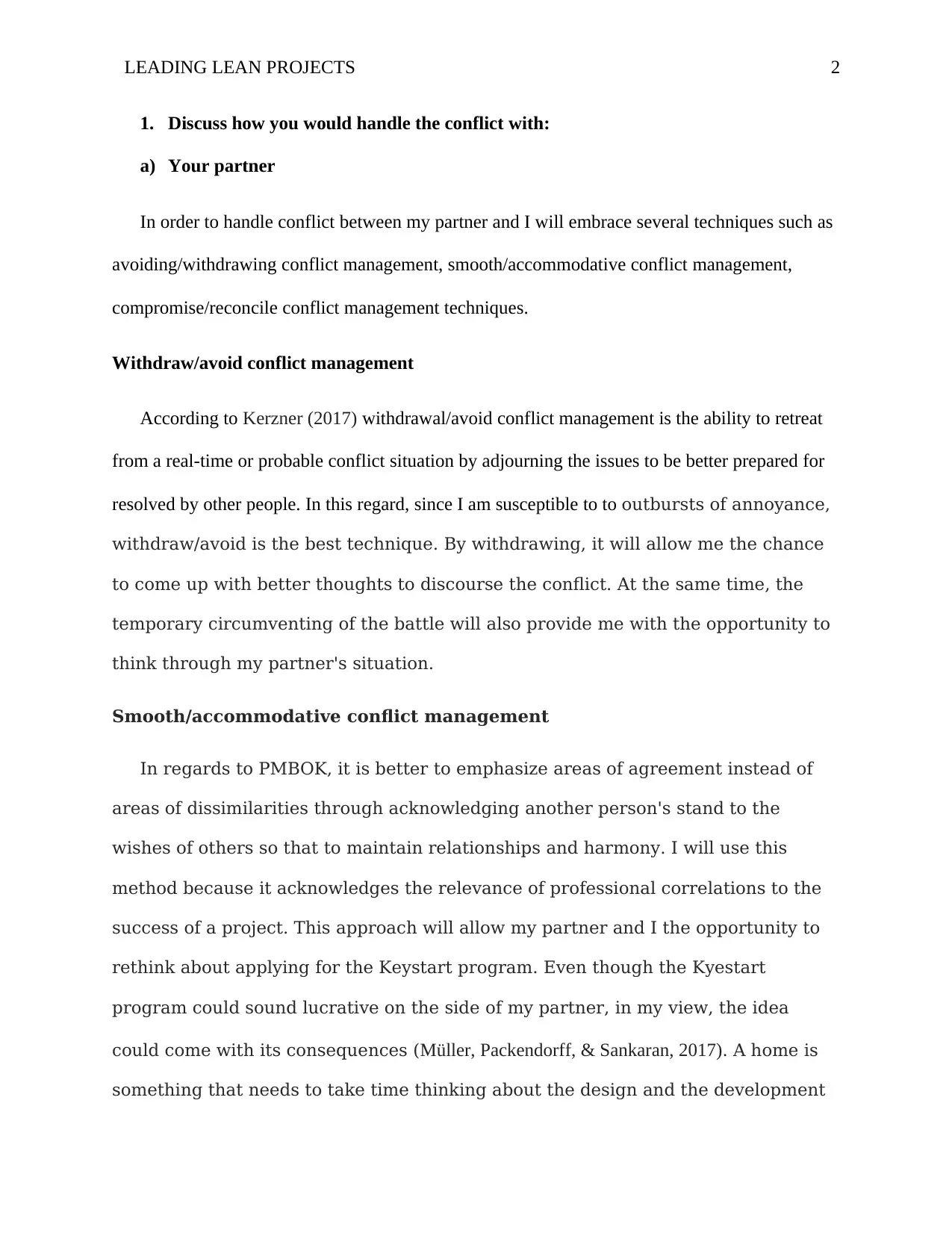
LEADING LEAN PROJECTS 2
1. Discuss how you would handle the conflict with:
a) Your partner
In order to handle conflict between my partner and I will embrace several techniques such as
avoiding/withdrawing conflict management, smooth/accommodative conflict management,
compromise/reconcile conflict management techniques.
Withdraw/avoid conflict management
According to Kerzner (2017) withdrawal/avoid conflict management is the ability to retreat
from a real-time or probable conflict situation by adjourning the issues to be better prepared for
resolved by other people. In this regard, since I am susceptible to to outbursts of annoyance,
withdraw/avoid is the best technique. By withdrawing, it will allow me the chance
to come up with better thoughts to discourse the conflict. At the same time, the
temporary circumventing of the battle will also provide me with the opportunity to
think through my partner's situation.
Smooth/accommodative conflict management
In regards to PMBOK, it is better to emphasize areas of agreement instead of
areas of dissimilarities through acknowledging another person's stand to the
wishes of others so that to maintain relationships and harmony. I will use this
method because it acknowledges the relevance of professional correlations to the
success of a project. This approach will allow my partner and I the opportunity to
rethink about applying for the Keystart program. Even though the Kyestart
program could sound lucrative on the side of my partner, in my view, the idea
could come with its consequences (Müller, Packendorff, & Sankaran, 2017). A home is
something that needs to take time thinking about the design and the development
1. Discuss how you would handle the conflict with:
a) Your partner
In order to handle conflict between my partner and I will embrace several techniques such as
avoiding/withdrawing conflict management, smooth/accommodative conflict management,
compromise/reconcile conflict management techniques.
Withdraw/avoid conflict management
According to Kerzner (2017) withdrawal/avoid conflict management is the ability to retreat
from a real-time or probable conflict situation by adjourning the issues to be better prepared for
resolved by other people. In this regard, since I am susceptible to to outbursts of annoyance,
withdraw/avoid is the best technique. By withdrawing, it will allow me the chance
to come up with better thoughts to discourse the conflict. At the same time, the
temporary circumventing of the battle will also provide me with the opportunity to
think through my partner's situation.
Smooth/accommodative conflict management
In regards to PMBOK, it is better to emphasize areas of agreement instead of
areas of dissimilarities through acknowledging another person's stand to the
wishes of others so that to maintain relationships and harmony. I will use this
method because it acknowledges the relevance of professional correlations to the
success of a project. This approach will allow my partner and I the opportunity to
rethink about applying for the Keystart program. Even though the Kyestart
program could sound lucrative on the side of my partner, in my view, the idea
could come with its consequences (Müller, Packendorff, & Sankaran, 2017). A home is
something that needs to take time thinking about the design and the development
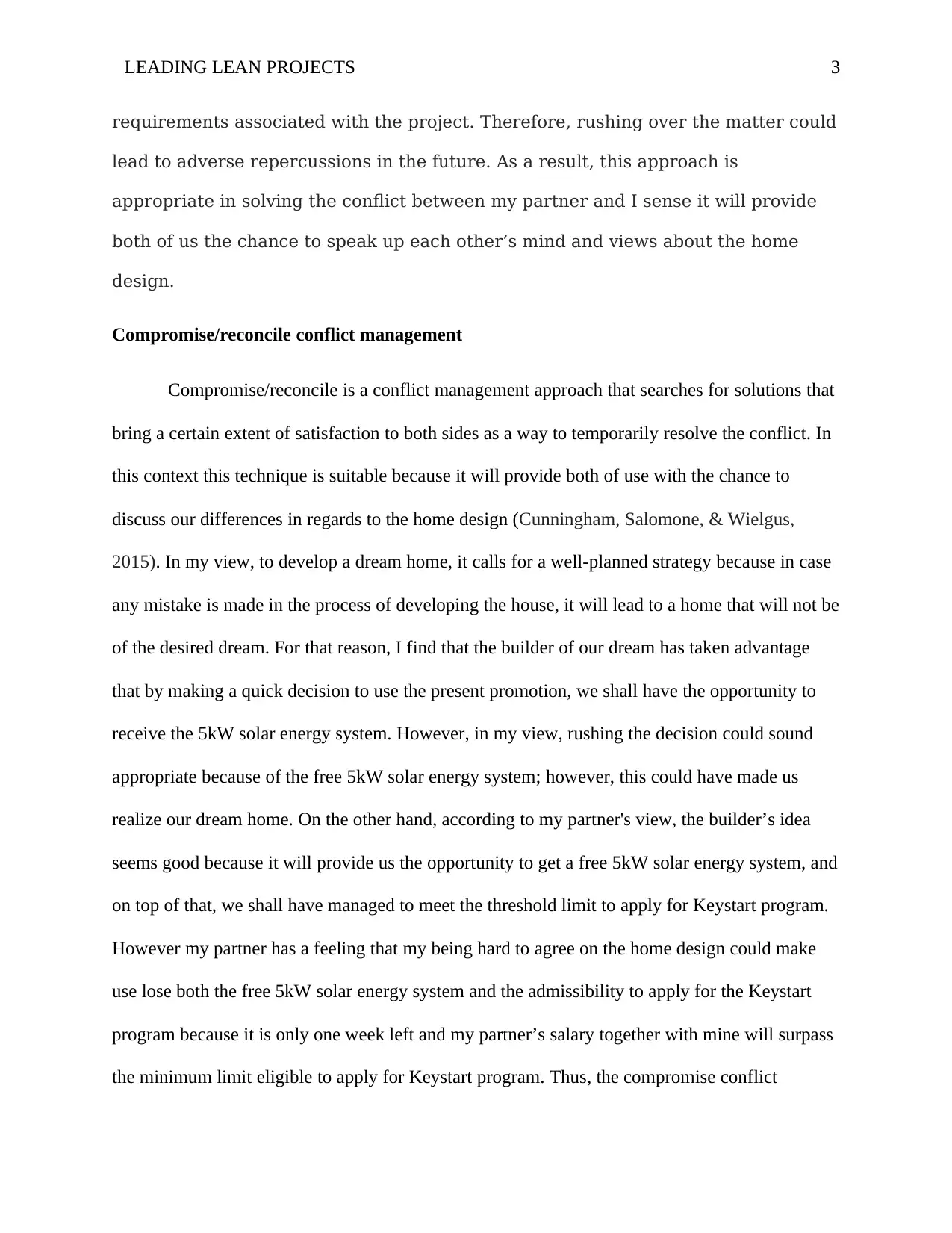
LEADING LEAN PROJECTS 3
requirements associated with the project. Therefore, rushing over the matter could
lead to adverse repercussions in the future. As a result, this approach is
appropriate in solving the conflict between my partner and I sense it will provide
both of us the chance to speak up each other’s mind and views about the home
design.
Compromise/reconcile conflict management
Compromise/reconcile is a conflict management approach that searches for solutions that
bring a certain extent of satisfaction to both sides as a way to temporarily resolve the conflict. In
this context this technique is suitable because it will provide both of use with the chance to
discuss our differences in regards to the home design (Cunningham, Salomone, & Wielgus,
2015). In my view, to develop a dream home, it calls for a well-planned strategy because in case
any mistake is made in the process of developing the house, it will lead to a home that will not be
of the desired dream. For that reason, I find that the builder of our dream has taken advantage
that by making a quick decision to use the present promotion, we shall have the opportunity to
receive the 5kW solar energy system. However, in my view, rushing the decision could sound
appropriate because of the free 5kW solar energy system; however, this could have made us
realize our dream home. On the other hand, according to my partner's view, the builder’s idea
seems good because it will provide us the opportunity to get a free 5kW solar energy system, and
on top of that, we shall have managed to meet the threshold limit to apply for Keystart program.
However my partner has a feeling that my being hard to agree on the home design could make
use lose both the free 5kW solar energy system and the admissibility to apply for the Keystart
program because it is only one week left and my partner’s salary together with mine will surpass
the minimum limit eligible to apply for Keystart program. Thus, the compromise conflict
requirements associated with the project. Therefore, rushing over the matter could
lead to adverse repercussions in the future. As a result, this approach is
appropriate in solving the conflict between my partner and I sense it will provide
both of us the chance to speak up each other’s mind and views about the home
design.
Compromise/reconcile conflict management
Compromise/reconcile is a conflict management approach that searches for solutions that
bring a certain extent of satisfaction to both sides as a way to temporarily resolve the conflict. In
this context this technique is suitable because it will provide both of use with the chance to
discuss our differences in regards to the home design (Cunningham, Salomone, & Wielgus,
2015). In my view, to develop a dream home, it calls for a well-planned strategy because in case
any mistake is made in the process of developing the house, it will lead to a home that will not be
of the desired dream. For that reason, I find that the builder of our dream has taken advantage
that by making a quick decision to use the present promotion, we shall have the opportunity to
receive the 5kW solar energy system. However, in my view, rushing the decision could sound
appropriate because of the free 5kW solar energy system; however, this could have made us
realize our dream home. On the other hand, according to my partner's view, the builder’s idea
seems good because it will provide us the opportunity to get a free 5kW solar energy system, and
on top of that, we shall have managed to meet the threshold limit to apply for Keystart program.
However my partner has a feeling that my being hard to agree on the home design could make
use lose both the free 5kW solar energy system and the admissibility to apply for the Keystart
program because it is only one week left and my partner’s salary together with mine will surpass
the minimum limit eligible to apply for Keystart program. Thus, the compromise conflict
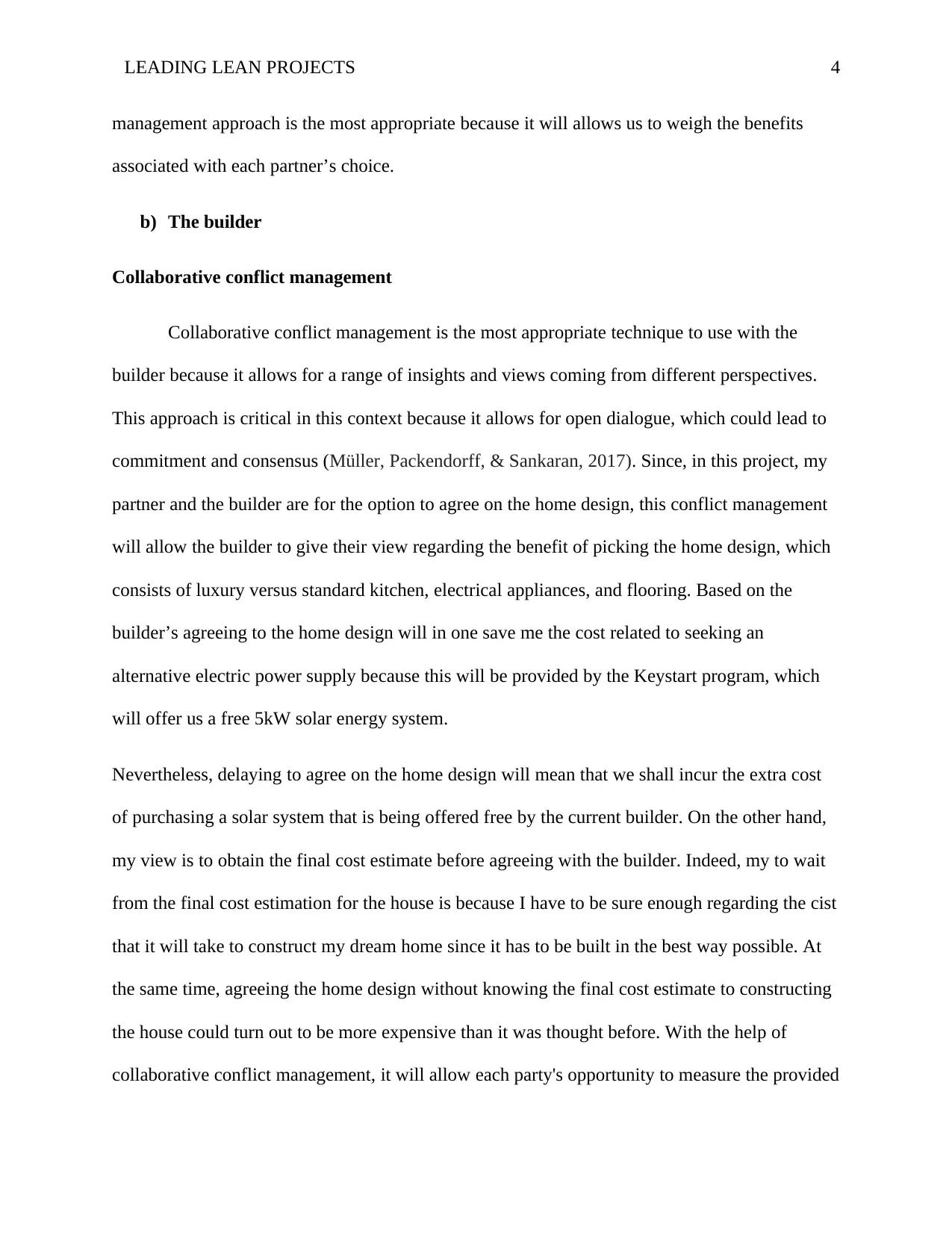
LEADING LEAN PROJECTS 4
management approach is the most appropriate because it will allows us to weigh the benefits
associated with each partner’s choice.
b) The builder
Collaborative conflict management
Collaborative conflict management is the most appropriate technique to use with the
builder because it allows for a range of insights and views coming from different perspectives.
This approach is critical in this context because it allows for open dialogue, which could lead to
commitment and consensus (Müller, Packendorff, & Sankaran, 2017). Since, in this project, my
partner and the builder are for the option to agree on the home design, this conflict management
will allow the builder to give their view regarding the benefit of picking the home design, which
consists of luxury versus standard kitchen, electrical appliances, and flooring. Based on the
builder’s agreeing to the home design will in one save me the cost related to seeking an
alternative electric power supply because this will be provided by the Keystart program, which
will offer us a free 5kW solar energy system.
Nevertheless, delaying to agree on the home design will mean that we shall incur the extra cost
of purchasing a solar system that is being offered free by the current builder. On the other hand,
my view is to obtain the final cost estimate before agreeing with the builder. Indeed, my to wait
from the final cost estimation for the house is because I have to be sure enough regarding the cist
that it will take to construct my dream home since it has to be built in the best way possible. At
the same time, agreeing the home design without knowing the final cost estimate to constructing
the house could turn out to be more expensive than it was thought before. With the help of
collaborative conflict management, it will allow each party's opportunity to measure the provided
management approach is the most appropriate because it will allows us to weigh the benefits
associated with each partner’s choice.
b) The builder
Collaborative conflict management
Collaborative conflict management is the most appropriate technique to use with the
builder because it allows for a range of insights and views coming from different perspectives.
This approach is critical in this context because it allows for open dialogue, which could lead to
commitment and consensus (Müller, Packendorff, & Sankaran, 2017). Since, in this project, my
partner and the builder are for the option to agree on the home design, this conflict management
will allow the builder to give their view regarding the benefit of picking the home design, which
consists of luxury versus standard kitchen, electrical appliances, and flooring. Based on the
builder’s agreeing to the home design will in one save me the cost related to seeking an
alternative electric power supply because this will be provided by the Keystart program, which
will offer us a free 5kW solar energy system.
Nevertheless, delaying to agree on the home design will mean that we shall incur the extra cost
of purchasing a solar system that is being offered free by the current builder. On the other hand,
my view is to obtain the final cost estimate before agreeing with the builder. Indeed, my to wait
from the final cost estimation for the house is because I have to be sure enough regarding the cist
that it will take to construct my dream home since it has to be built in the best way possible. At
the same time, agreeing the home design without knowing the final cost estimate to constructing
the house could turn out to be more expensive than it was thought before. With the help of
collaborative conflict management, it will allow each party's opportunity to measure the provided
Secure Best Marks with AI Grader
Need help grading? Try our AI Grader for instant feedback on your assignments.
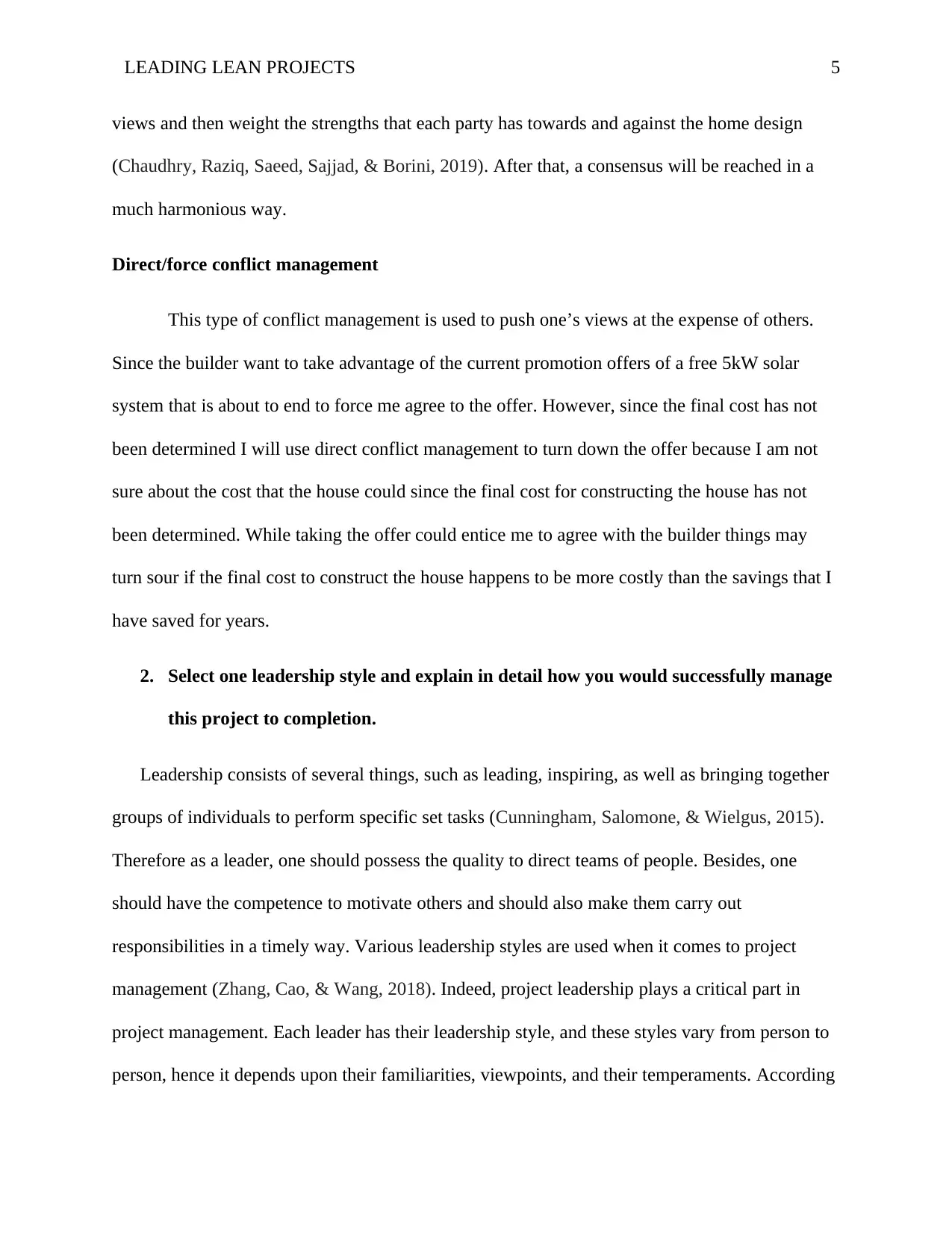
LEADING LEAN PROJECTS 5
views and then weight the strengths that each party has towards and against the home design
(Chaudhry, Raziq, Saeed, Sajjad, & Borini, 2019). After that, a consensus will be reached in a
much harmonious way.
Direct/force conflict management
This type of conflict management is used to push one’s views at the expense of others.
Since the builder want to take advantage of the current promotion offers of a free 5kW solar
system that is about to end to force me agree to the offer. However, since the final cost has not
been determined I will use direct conflict management to turn down the offer because I am not
sure about the cost that the house could since the final cost for constructing the house has not
been determined. While taking the offer could entice me to agree with the builder things may
turn sour if the final cost to construct the house happens to be more costly than the savings that I
have saved for years.
2. Select one leadership style and explain in detail how you would successfully manage
this project to completion.
Leadership consists of several things, such as leading, inspiring, as well as bringing together
groups of individuals to perform specific set tasks (Cunningham, Salomone, & Wielgus, 2015).
Therefore as a leader, one should possess the quality to direct teams of people. Besides, one
should have the competence to motivate others and should also make them carry out
responsibilities in a timely way. Various leadership styles are used when it comes to project
management (Zhang, Cao, & Wang, 2018). Indeed, project leadership plays a critical part in
project management. Each leader has their leadership style, and these styles vary from person to
person, hence it depends upon their familiarities, viewpoints, and their temperaments. According
views and then weight the strengths that each party has towards and against the home design
(Chaudhry, Raziq, Saeed, Sajjad, & Borini, 2019). After that, a consensus will be reached in a
much harmonious way.
Direct/force conflict management
This type of conflict management is used to push one’s views at the expense of others.
Since the builder want to take advantage of the current promotion offers of a free 5kW solar
system that is about to end to force me agree to the offer. However, since the final cost has not
been determined I will use direct conflict management to turn down the offer because I am not
sure about the cost that the house could since the final cost for constructing the house has not
been determined. While taking the offer could entice me to agree with the builder things may
turn sour if the final cost to construct the house happens to be more costly than the savings that I
have saved for years.
2. Select one leadership style and explain in detail how you would successfully manage
this project to completion.
Leadership consists of several things, such as leading, inspiring, as well as bringing together
groups of individuals to perform specific set tasks (Cunningham, Salomone, & Wielgus, 2015).
Therefore as a leader, one should possess the quality to direct teams of people. Besides, one
should have the competence to motivate others and should also make them carry out
responsibilities in a timely way. Various leadership styles are used when it comes to project
management (Zhang, Cao, & Wang, 2018). Indeed, project leadership plays a critical part in
project management. Each leader has their leadership style, and these styles vary from person to
person, hence it depends upon their familiarities, viewpoints, and their temperaments. According
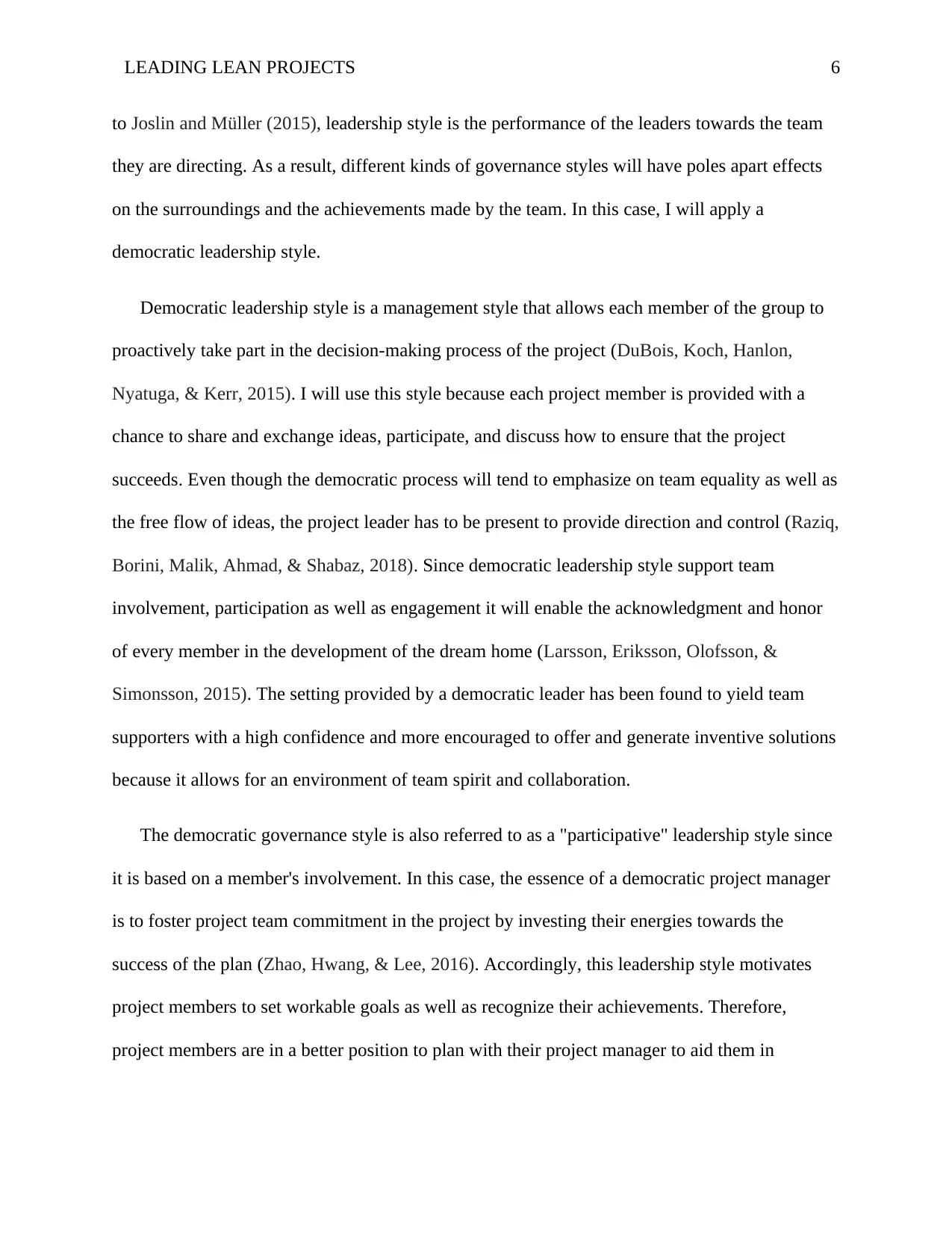
LEADING LEAN PROJECTS 6
to Joslin and Müller (2015), leadership style is the performance of the leaders towards the team
they are directing. As a result, different kinds of governance styles will have poles apart effects
on the surroundings and the achievements made by the team. In this case, I will apply a
democratic leadership style.
Democratic leadership style is a management style that allows each member of the group to
proactively take part in the decision-making process of the project (DuBois, Koch, Hanlon,
Nyatuga, & Kerr, 2015). I will use this style because each project member is provided with a
chance to share and exchange ideas, participate, and discuss how to ensure that the project
succeeds. Even though the democratic process will tend to emphasize on team equality as well as
the free flow of ideas, the project leader has to be present to provide direction and control (Raziq,
Borini, Malik, Ahmad, & Shabaz, 2018). Since democratic leadership style support team
involvement, participation as well as engagement it will enable the acknowledgment and honor
of every member in the development of the dream home (Larsson, Eriksson, Olofsson, &
Simonsson, 2015). The setting provided by a democratic leader has been found to yield team
supporters with a high confidence and more encouraged to offer and generate inventive solutions
because it allows for an environment of team spirit and collaboration.
The democratic governance style is also referred to as a "participative" leadership style since
it is based on a member's involvement. In this case, the essence of a democratic project manager
is to foster project team commitment in the project by investing their energies towards the
success of the plan (Zhao, Hwang, & Lee, 2016). Accordingly, this leadership style motivates
project members to set workable goals as well as recognize their achievements. Therefore,
project members are in a better position to plan with their project manager to aid them in
to Joslin and Müller (2015), leadership style is the performance of the leaders towards the team
they are directing. As a result, different kinds of governance styles will have poles apart effects
on the surroundings and the achievements made by the team. In this case, I will apply a
democratic leadership style.
Democratic leadership style is a management style that allows each member of the group to
proactively take part in the decision-making process of the project (DuBois, Koch, Hanlon,
Nyatuga, & Kerr, 2015). I will use this style because each project member is provided with a
chance to share and exchange ideas, participate, and discuss how to ensure that the project
succeeds. Even though the democratic process will tend to emphasize on team equality as well as
the free flow of ideas, the project leader has to be present to provide direction and control (Raziq,
Borini, Malik, Ahmad, & Shabaz, 2018). Since democratic leadership style support team
involvement, participation as well as engagement it will enable the acknowledgment and honor
of every member in the development of the dream home (Larsson, Eriksson, Olofsson, &
Simonsson, 2015). The setting provided by a democratic leader has been found to yield team
supporters with a high confidence and more encouraged to offer and generate inventive solutions
because it allows for an environment of team spirit and collaboration.
The democratic governance style is also referred to as a "participative" leadership style since
it is based on a member's involvement. In this case, the essence of a democratic project manager
is to foster project team commitment in the project by investing their energies towards the
success of the plan (Zhao, Hwang, & Lee, 2016). Accordingly, this leadership style motivates
project members to set workable goals as well as recognize their achievements. Therefore,
project members are in a better position to plan with their project manager to aid them in
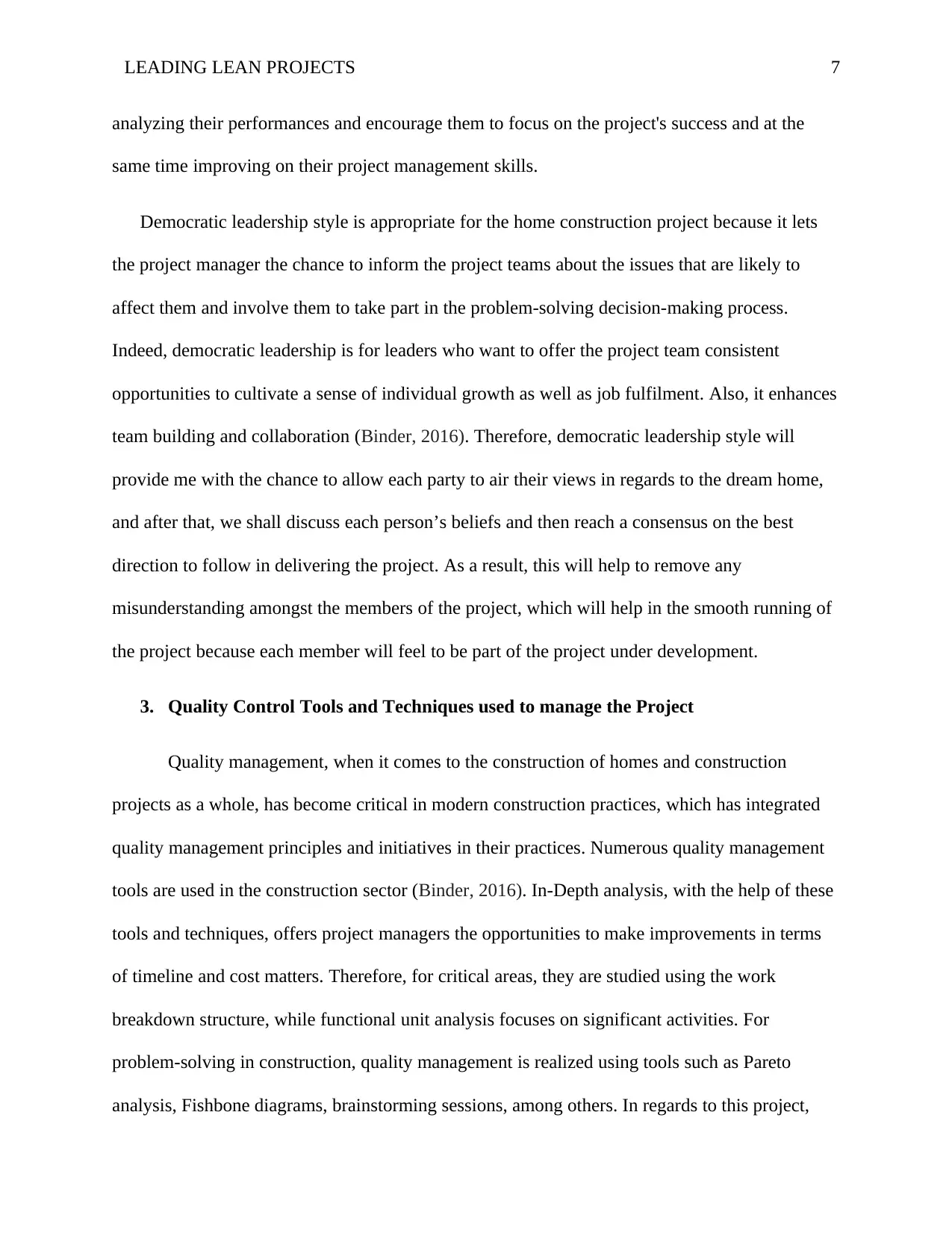
LEADING LEAN PROJECTS 7
analyzing their performances and encourage them to focus on the project's success and at the
same time improving on their project management skills.
Democratic leadership style is appropriate for the home construction project because it lets
the project manager the chance to inform the project teams about the issues that are likely to
affect them and involve them to take part in the problem-solving decision-making process.
Indeed, democratic leadership is for leaders who want to offer the project team consistent
opportunities to cultivate a sense of individual growth as well as job fulfilment. Also, it enhances
team building and collaboration (Binder, 2016). Therefore, democratic leadership style will
provide me with the chance to allow each party to air their views in regards to the dream home,
and after that, we shall discuss each person’s beliefs and then reach a consensus on the best
direction to follow in delivering the project. As a result, this will help to remove any
misunderstanding amongst the members of the project, which will help in the smooth running of
the project because each member will feel to be part of the project under development.
3. Quality Control Tools and Techniques used to manage the Project
Quality management, when it comes to the construction of homes and construction
projects as a whole, has become critical in modern construction practices, which has integrated
quality management principles and initiatives in their practices. Numerous quality management
tools are used in the construction sector (Binder, 2016). In-Depth analysis, with the help of these
tools and techniques, offers project managers the opportunities to make improvements in terms
of timeline and cost matters. Therefore, for critical areas, they are studied using the work
breakdown structure, while functional unit analysis focuses on significant activities. For
problem-solving in construction, quality management is realized using tools such as Pareto
analysis, Fishbone diagrams, brainstorming sessions, among others. In regards to this project,
analyzing their performances and encourage them to focus on the project's success and at the
same time improving on their project management skills.
Democratic leadership style is appropriate for the home construction project because it lets
the project manager the chance to inform the project teams about the issues that are likely to
affect them and involve them to take part in the problem-solving decision-making process.
Indeed, democratic leadership is for leaders who want to offer the project team consistent
opportunities to cultivate a sense of individual growth as well as job fulfilment. Also, it enhances
team building and collaboration (Binder, 2016). Therefore, democratic leadership style will
provide me with the chance to allow each party to air their views in regards to the dream home,
and after that, we shall discuss each person’s beliefs and then reach a consensus on the best
direction to follow in delivering the project. As a result, this will help to remove any
misunderstanding amongst the members of the project, which will help in the smooth running of
the project because each member will feel to be part of the project under development.
3. Quality Control Tools and Techniques used to manage the Project
Quality management, when it comes to the construction of homes and construction
projects as a whole, has become critical in modern construction practices, which has integrated
quality management principles and initiatives in their practices. Numerous quality management
tools are used in the construction sector (Binder, 2016). In-Depth analysis, with the help of these
tools and techniques, offers project managers the opportunities to make improvements in terms
of timeline and cost matters. Therefore, for critical areas, they are studied using the work
breakdown structure, while functional unit analysis focuses on significant activities. For
problem-solving in construction, quality management is realized using tools such as Pareto
analysis, Fishbone diagrams, brainstorming sessions, among others. In regards to this project,
Paraphrase This Document
Need a fresh take? Get an instant paraphrase of this document with our AI Paraphraser
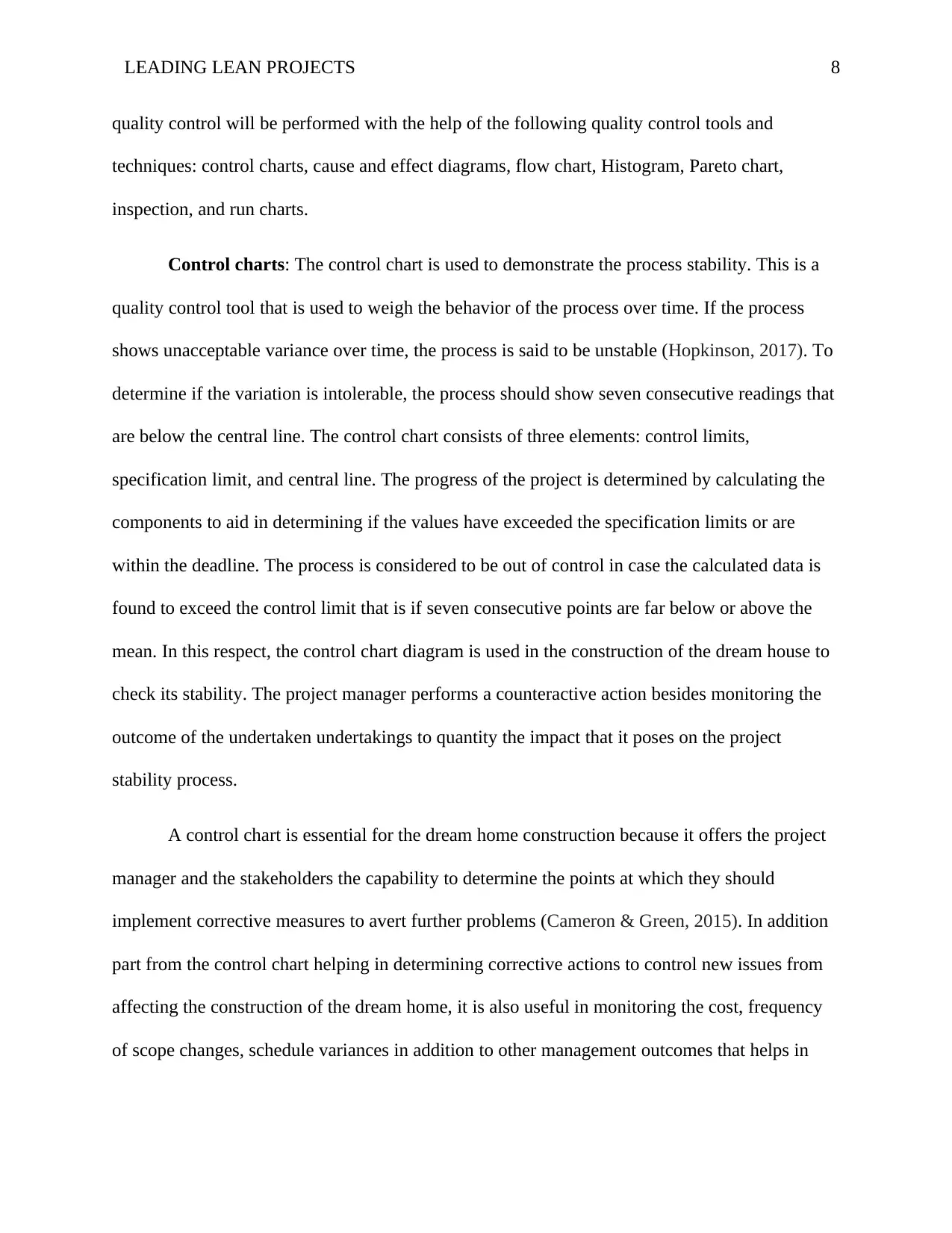
LEADING LEAN PROJECTS 8
quality control will be performed with the help of the following quality control tools and
techniques: control charts, cause and effect diagrams, flow chart, Histogram, Pareto chart,
inspection, and run charts.
Control charts: The control chart is used to demonstrate the process stability. This is a
quality control tool that is used to weigh the behavior of the process over time. If the process
shows unacceptable variance over time, the process is said to be unstable (Hopkinson, 2017). To
determine if the variation is intolerable, the process should show seven consecutive readings that
are below the central line. The control chart consists of three elements: control limits,
specification limit, and central line. The progress of the project is determined by calculating the
components to aid in determining if the values have exceeded the specification limits or are
within the deadline. The process is considered to be out of control in case the calculated data is
found to exceed the control limit that is if seven consecutive points are far below or above the
mean. In this respect, the control chart diagram is used in the construction of the dream house to
check its stability. The project manager performs a counteractive action besides monitoring the
outcome of the undertaken undertakings to quantity the impact that it poses on the project
stability process.
A control chart is essential for the dream home construction because it offers the project
manager and the stakeholders the capability to determine the points at which they should
implement corrective measures to avert further problems (Cameron & Green, 2015). In addition
part from the control chart helping in determining corrective actions to control new issues from
affecting the construction of the dream home, it is also useful in monitoring the cost, frequency
of scope changes, schedule variances in addition to other management outcomes that helps in
quality control will be performed with the help of the following quality control tools and
techniques: control charts, cause and effect diagrams, flow chart, Histogram, Pareto chart,
inspection, and run charts.
Control charts: The control chart is used to demonstrate the process stability. This is a
quality control tool that is used to weigh the behavior of the process over time. If the process
shows unacceptable variance over time, the process is said to be unstable (Hopkinson, 2017). To
determine if the variation is intolerable, the process should show seven consecutive readings that
are below the central line. The control chart consists of three elements: control limits,
specification limit, and central line. The progress of the project is determined by calculating the
components to aid in determining if the values have exceeded the specification limits or are
within the deadline. The process is considered to be out of control in case the calculated data is
found to exceed the control limit that is if seven consecutive points are far below or above the
mean. In this respect, the control chart diagram is used in the construction of the dream house to
check its stability. The project manager performs a counteractive action besides monitoring the
outcome of the undertaken undertakings to quantity the impact that it poses on the project
stability process.
A control chart is essential for the dream home construction because it offers the project
manager and the stakeholders the capability to determine the points at which they should
implement corrective measures to avert further problems (Cameron & Green, 2015). In addition
part from the control chart helping in determining corrective actions to control new issues from
affecting the construction of the dream home, it is also useful in monitoring the cost, frequency
of scope changes, schedule variances in addition to other management outcomes that helps in
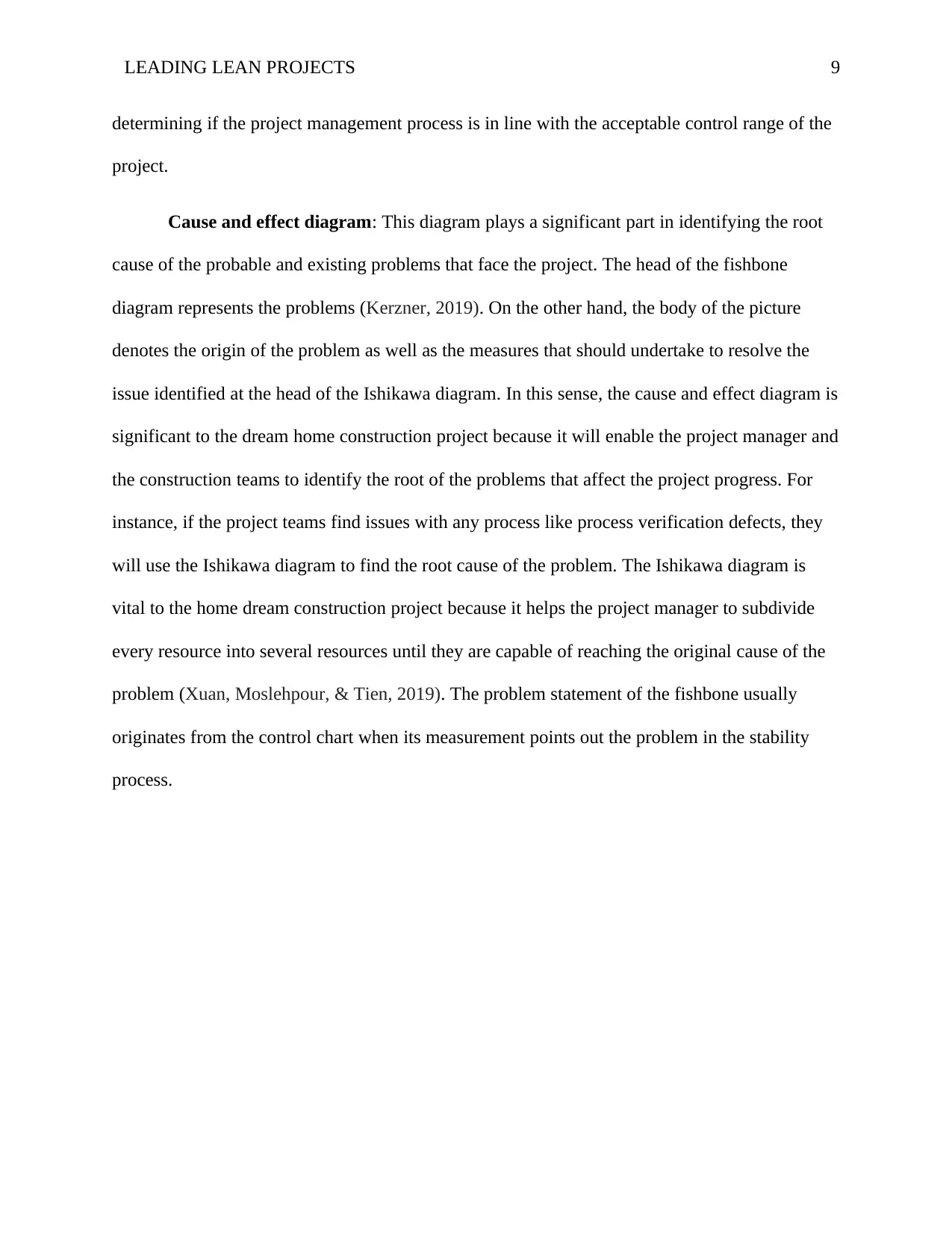
LEADING LEAN PROJECTS 9
determining if the project management process is in line with the acceptable control range of the
project.
Cause and effect diagram: This diagram plays a significant part in identifying the root
cause of the probable and existing problems that face the project. The head of the fishbone
diagram represents the problems (Kerzner, 2019). On the other hand, the body of the picture
denotes the origin of the problem as well as the measures that should undertake to resolve the
issue identified at the head of the Ishikawa diagram. In this sense, the cause and effect diagram is
significant to the dream home construction project because it will enable the project manager and
the construction teams to identify the root of the problems that affect the project progress. For
instance, if the project teams find issues with any process like process verification defects, they
will use the Ishikawa diagram to find the root cause of the problem. The Ishikawa diagram is
vital to the home dream construction project because it helps the project manager to subdivide
every resource into several resources until they are capable of reaching the original cause of the
problem (Xuan, Moslehpour, & Tien, 2019). The problem statement of the fishbone usually
originates from the control chart when its measurement points out the problem in the stability
process.
determining if the project management process is in line with the acceptable control range of the
project.
Cause and effect diagram: This diagram plays a significant part in identifying the root
cause of the probable and existing problems that face the project. The head of the fishbone
diagram represents the problems (Kerzner, 2019). On the other hand, the body of the picture
denotes the origin of the problem as well as the measures that should undertake to resolve the
issue identified at the head of the Ishikawa diagram. In this sense, the cause and effect diagram is
significant to the dream home construction project because it will enable the project manager and
the construction teams to identify the root of the problems that affect the project progress. For
instance, if the project teams find issues with any process like process verification defects, they
will use the Ishikawa diagram to find the root cause of the problem. The Ishikawa diagram is
vital to the home dream construction project because it helps the project manager to subdivide
every resource into several resources until they are capable of reaching the original cause of the
problem (Xuan, Moslehpour, & Tien, 2019). The problem statement of the fishbone usually
originates from the control chart when its measurement points out the problem in the stability
process.
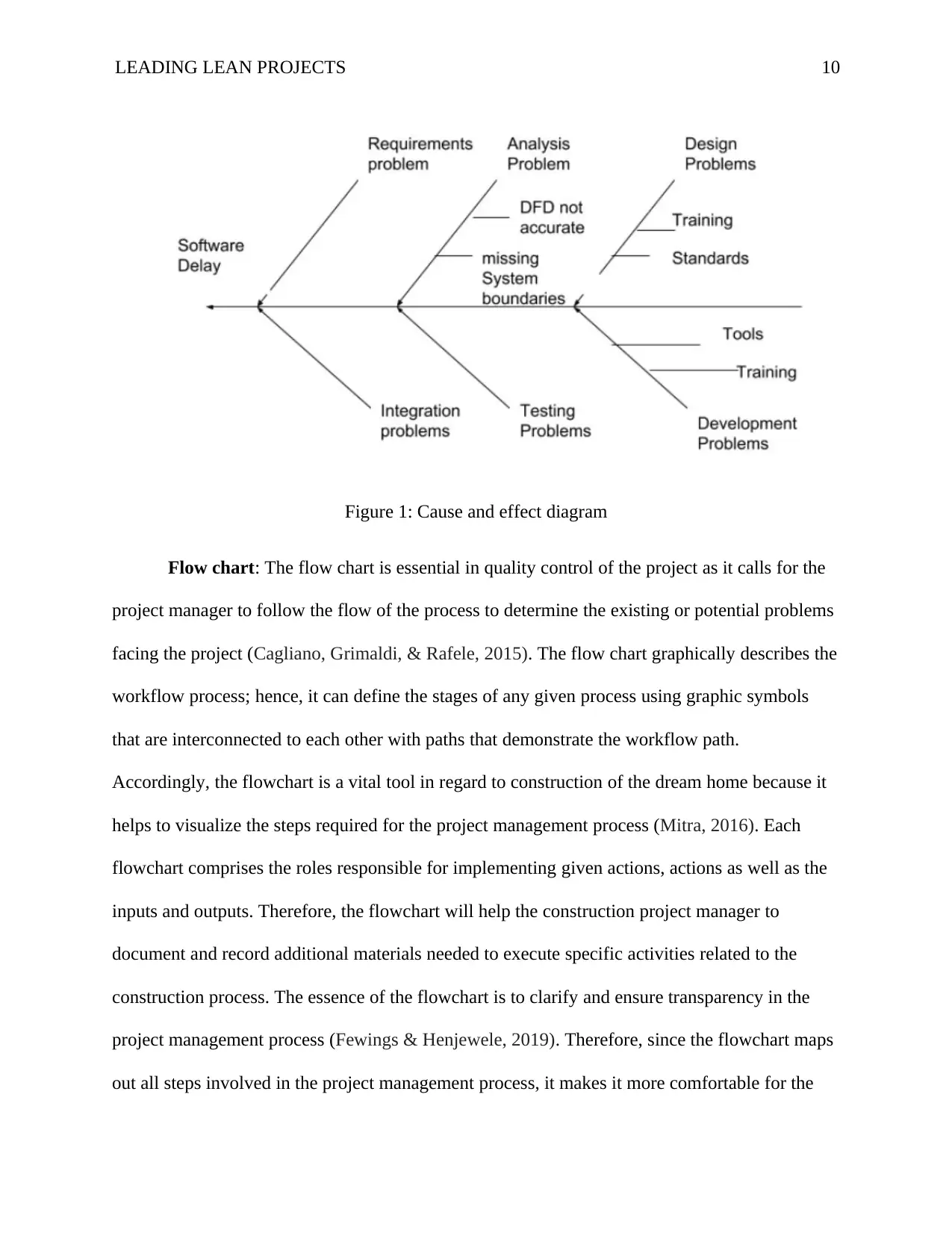
LEADING LEAN PROJECTS 10
Figure 1: Cause and effect diagram
Flow chart: The flow chart is essential in quality control of the project as it calls for the
project manager to follow the flow of the process to determine the existing or potential problems
facing the project (Cagliano, Grimaldi, & Rafele, 2015). The flow chart graphically describes the
workflow process; hence, it can define the stages of any given process using graphic symbols
that are interconnected to each other with paths that demonstrate the workflow path.
Accordingly, the flowchart is a vital tool in regard to construction of the dream home because it
helps to visualize the steps required for the project management process (Mitra, 2016). Each
flowchart comprises the roles responsible for implementing given actions, actions as well as the
inputs and outputs. Therefore, the flowchart will help the construction project manager to
document and record additional materials needed to execute specific activities related to the
construction process. The essence of the flowchart is to clarify and ensure transparency in the
project management process (Fewings & Henjewele, 2019). Therefore, since the flowchart maps
out all steps involved in the project management process, it makes it more comfortable for the
Figure 1: Cause and effect diagram
Flow chart: The flow chart is essential in quality control of the project as it calls for the
project manager to follow the flow of the process to determine the existing or potential problems
facing the project (Cagliano, Grimaldi, & Rafele, 2015). The flow chart graphically describes the
workflow process; hence, it can define the stages of any given process using graphic symbols
that are interconnected to each other with paths that demonstrate the workflow path.
Accordingly, the flowchart is a vital tool in regard to construction of the dream home because it
helps to visualize the steps required for the project management process (Mitra, 2016). Each
flowchart comprises the roles responsible for implementing given actions, actions as well as the
inputs and outputs. Therefore, the flowchart will help the construction project manager to
document and record additional materials needed to execute specific activities related to the
construction process. The essence of the flowchart is to clarify and ensure transparency in the
project management process (Fewings & Henjewele, 2019). Therefore, since the flowchart maps
out all steps involved in the project management process, it makes it more comfortable for the
Secure Best Marks with AI Grader
Need help grading? Try our AI Grader for instant feedback on your assignments.
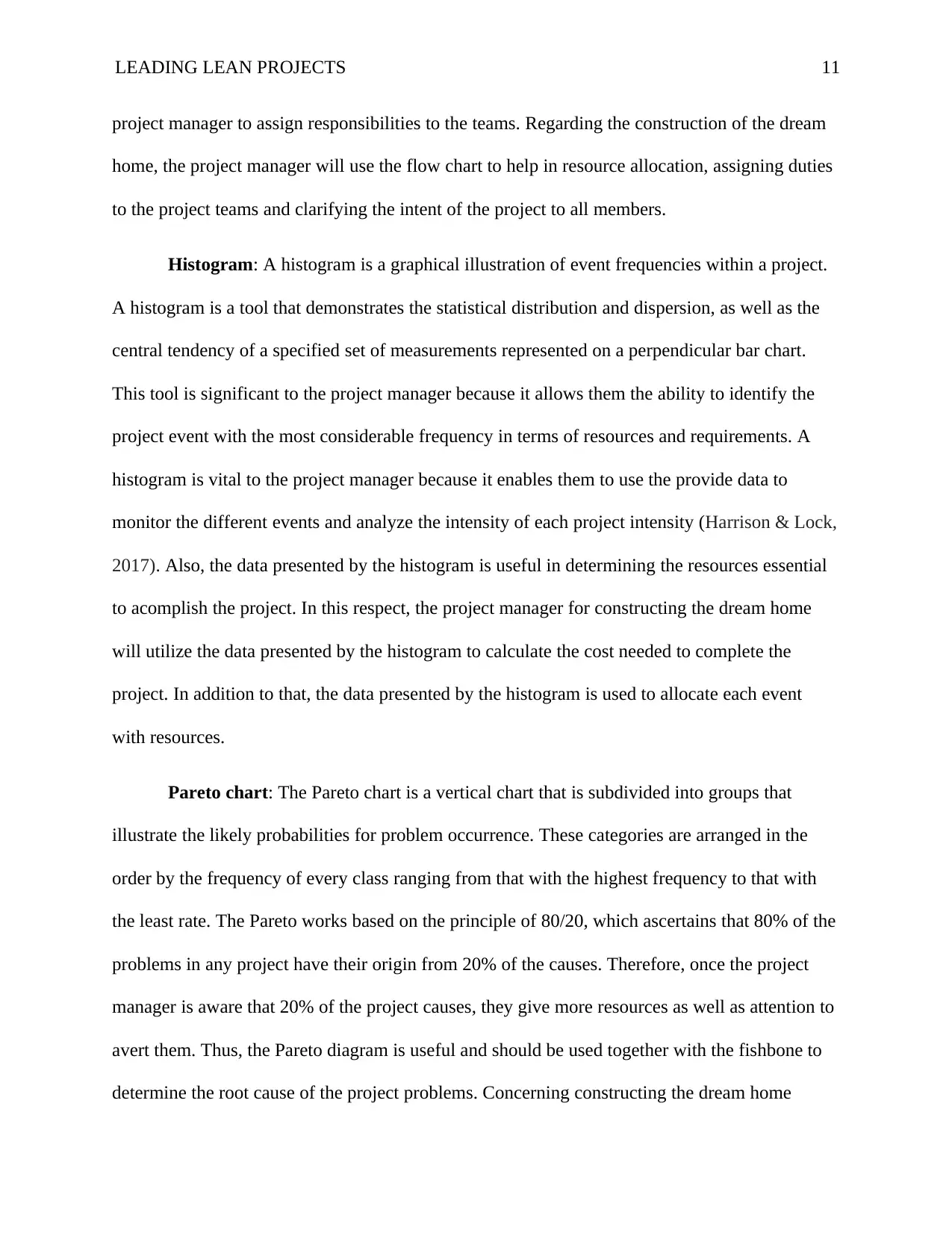
LEADING LEAN PROJECTS 11
project manager to assign responsibilities to the teams. Regarding the construction of the dream
home, the project manager will use the flow chart to help in resource allocation, assigning duties
to the project teams and clarifying the intent of the project to all members.
Histogram: A histogram is a graphical illustration of event frequencies within a project.
A histogram is a tool that demonstrates the statistical distribution and dispersion, as well as the
central tendency of a specified set of measurements represented on a perpendicular bar chart.
This tool is significant to the project manager because it allows them the ability to identify the
project event with the most considerable frequency in terms of resources and requirements. A
histogram is vital to the project manager because it enables them to use the provide data to
monitor the different events and analyze the intensity of each project intensity (Harrison & Lock,
2017). Also, the data presented by the histogram is useful in determining the resources essential
to acomplish the project. In this respect, the project manager for constructing the dream home
will utilize the data presented by the histogram to calculate the cost needed to complete the
project. In addition to that, the data presented by the histogram is used to allocate each event
with resources.
Pareto chart: The Pareto chart is a vertical chart that is subdivided into groups that
illustrate the likely probabilities for problem occurrence. These categories are arranged in the
order by the frequency of every class ranging from that with the highest frequency to that with
the least rate. The Pareto works based on the principle of 80/20, which ascertains that 80% of the
problems in any project have their origin from 20% of the causes. Therefore, once the project
manager is aware that 20% of the project causes, they give more resources as well as attention to
avert them. Thus, the Pareto diagram is useful and should be used together with the fishbone to
determine the root cause of the project problems. Concerning constructing the dream home
project manager to assign responsibilities to the teams. Regarding the construction of the dream
home, the project manager will use the flow chart to help in resource allocation, assigning duties
to the project teams and clarifying the intent of the project to all members.
Histogram: A histogram is a graphical illustration of event frequencies within a project.
A histogram is a tool that demonstrates the statistical distribution and dispersion, as well as the
central tendency of a specified set of measurements represented on a perpendicular bar chart.
This tool is significant to the project manager because it allows them the ability to identify the
project event with the most considerable frequency in terms of resources and requirements. A
histogram is vital to the project manager because it enables them to use the provide data to
monitor the different events and analyze the intensity of each project intensity (Harrison & Lock,
2017). Also, the data presented by the histogram is useful in determining the resources essential
to acomplish the project. In this respect, the project manager for constructing the dream home
will utilize the data presented by the histogram to calculate the cost needed to complete the
project. In addition to that, the data presented by the histogram is used to allocate each event
with resources.
Pareto chart: The Pareto chart is a vertical chart that is subdivided into groups that
illustrate the likely probabilities for problem occurrence. These categories are arranged in the
order by the frequency of every class ranging from that with the highest frequency to that with
the least rate. The Pareto works based on the principle of 80/20, which ascertains that 80% of the
problems in any project have their origin from 20% of the causes. Therefore, once the project
manager is aware that 20% of the project causes, they give more resources as well as attention to
avert them. Thus, the Pareto diagram is useful and should be used together with the fishbone to
determine the root cause of the project problems. Concerning constructing the dream home
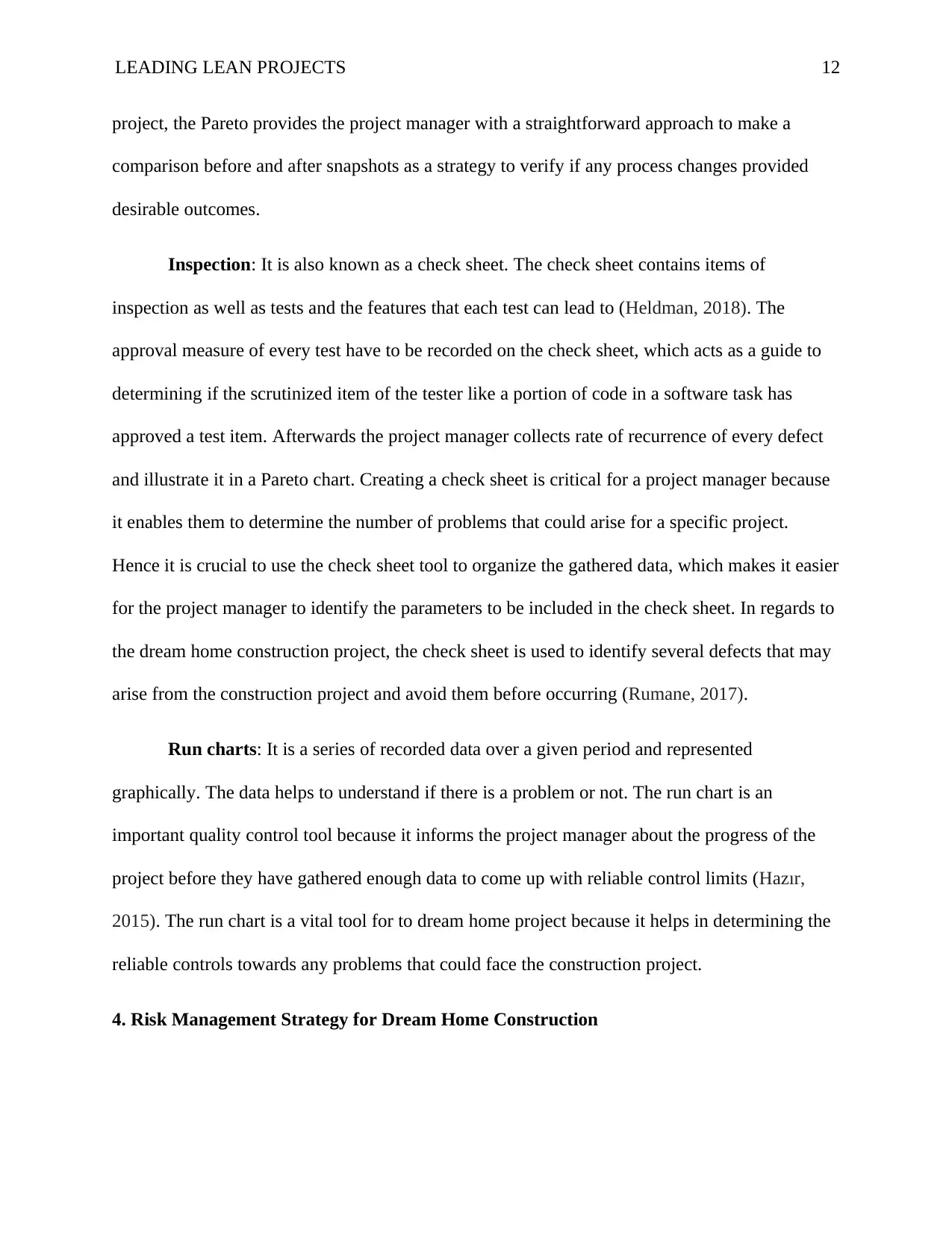
LEADING LEAN PROJECTS 12
project, the Pareto provides the project manager with a straightforward approach to make a
comparison before and after snapshots as a strategy to verify if any process changes provided
desirable outcomes.
Inspection: It is also known as a check sheet. The check sheet contains items of
inspection as well as tests and the features that each test can lead to (Heldman, 2018). The
approval measure of every test have to be recorded on the check sheet, which acts as a guide to
determining if the scrutinized item of the tester like a portion of code in a software task has
approved a test item. Afterwards the project manager collects rate of recurrence of every defect
and illustrate it in a Pareto chart. Creating a check sheet is critical for a project manager because
it enables them to determine the number of problems that could arise for a specific project.
Hence it is crucial to use the check sheet tool to organize the gathered data, which makes it easier
for the project manager to identify the parameters to be included in the check sheet. In regards to
the dream home construction project, the check sheet is used to identify several defects that may
arise from the construction project and avoid them before occurring (Rumane, 2017).
Run charts: It is a series of recorded data over a given period and represented
graphically. The data helps to understand if there is a problem or not. The run chart is an
important quality control tool because it informs the project manager about the progress of the
project before they have gathered enough data to come up with reliable control limits (Hazır,
2015). The run chart is a vital tool for to dream home project because it helps in determining the
reliable controls towards any problems that could face the construction project.
4. Risk Management Strategy for Dream Home Construction
project, the Pareto provides the project manager with a straightforward approach to make a
comparison before and after snapshots as a strategy to verify if any process changes provided
desirable outcomes.
Inspection: It is also known as a check sheet. The check sheet contains items of
inspection as well as tests and the features that each test can lead to (Heldman, 2018). The
approval measure of every test have to be recorded on the check sheet, which acts as a guide to
determining if the scrutinized item of the tester like a portion of code in a software task has
approved a test item. Afterwards the project manager collects rate of recurrence of every defect
and illustrate it in a Pareto chart. Creating a check sheet is critical for a project manager because
it enables them to determine the number of problems that could arise for a specific project.
Hence it is crucial to use the check sheet tool to organize the gathered data, which makes it easier
for the project manager to identify the parameters to be included in the check sheet. In regards to
the dream home construction project, the check sheet is used to identify several defects that may
arise from the construction project and avoid them before occurring (Rumane, 2017).
Run charts: It is a series of recorded data over a given period and represented
graphically. The data helps to understand if there is a problem or not. The run chart is an
important quality control tool because it informs the project manager about the progress of the
project before they have gathered enough data to come up with reliable control limits (Hazır,
2015). The run chart is a vital tool for to dream home project because it helps in determining the
reliable controls towards any problems that could face the construction project.
4. Risk Management Strategy for Dream Home Construction
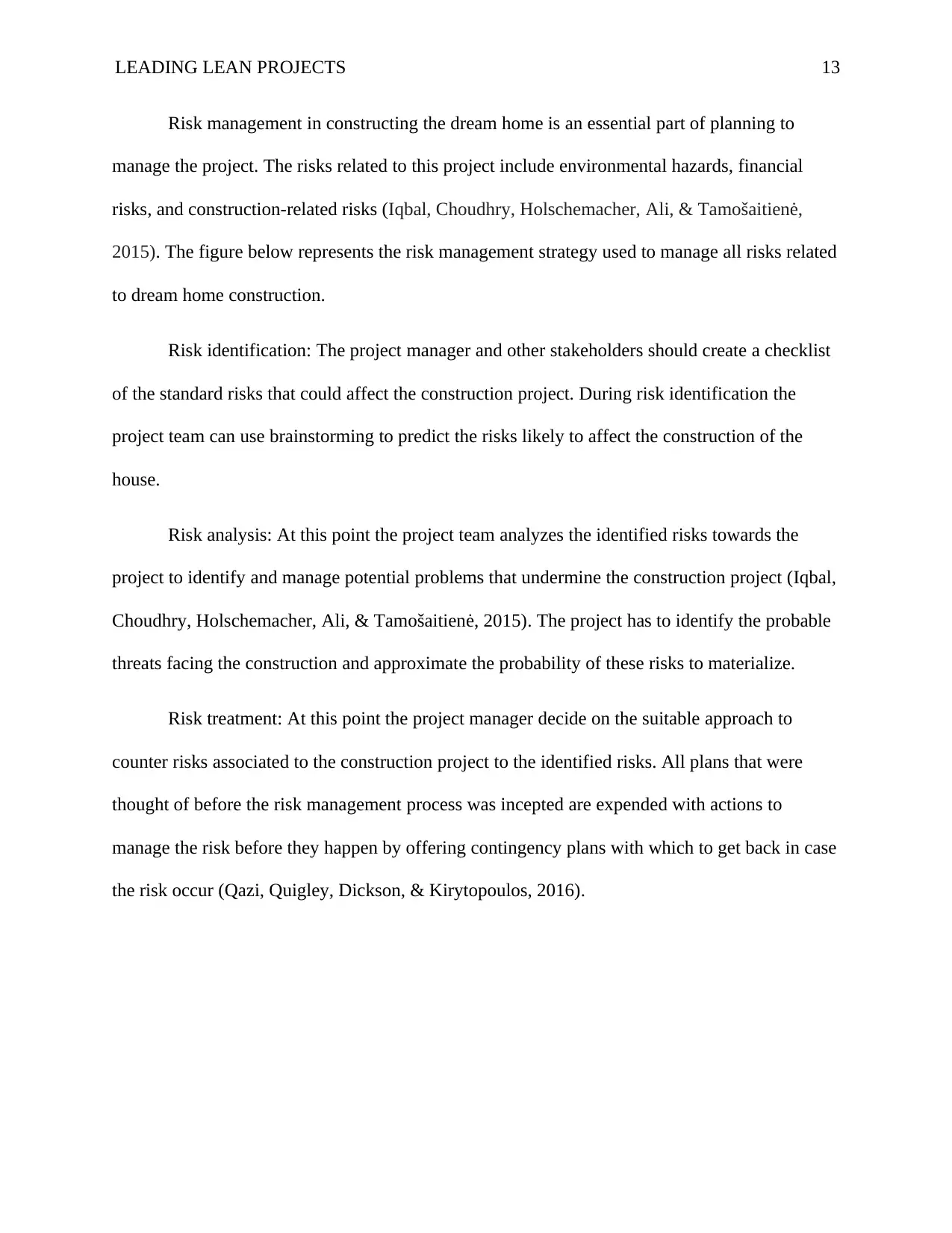
LEADING LEAN PROJECTS 13
Risk management in constructing the dream home is an essential part of planning to
manage the project. The risks related to this project include environmental hazards, financial
risks, and construction-related risks (Iqbal, Choudhry, Holschemacher, Ali, & Tamošaitienė,
2015). The figure below represents the risk management strategy used to manage all risks related
to dream home construction.
Risk identification: The project manager and other stakeholders should create a checklist
of the standard risks that could affect the construction project. During risk identification the
project team can use brainstorming to predict the risks likely to affect the construction of the
house.
Risk analysis: At this point the project team analyzes the identified risks towards the
project to identify and manage potential problems that undermine the construction project (Iqbal,
Choudhry, Holschemacher, Ali, & Tamošaitienė, 2015). The project has to identify the probable
threats facing the construction and approximate the probability of these risks to materialize.
Risk treatment: At this point the project manager decide on the suitable approach to
counter risks associated to the construction project to the identified risks. All plans that were
thought of before the risk management process was incepted are expended with actions to
manage the risk before they happen by offering contingency plans with which to get back in case
the risk occur (Qazi, Quigley, Dickson, & Kirytopoulos, 2016).
Risk management in constructing the dream home is an essential part of planning to
manage the project. The risks related to this project include environmental hazards, financial
risks, and construction-related risks (Iqbal, Choudhry, Holschemacher, Ali, & Tamošaitienė,
2015). The figure below represents the risk management strategy used to manage all risks related
to dream home construction.
Risk identification: The project manager and other stakeholders should create a checklist
of the standard risks that could affect the construction project. During risk identification the
project team can use brainstorming to predict the risks likely to affect the construction of the
house.
Risk analysis: At this point the project team analyzes the identified risks towards the
project to identify and manage potential problems that undermine the construction project (Iqbal,
Choudhry, Holschemacher, Ali, & Tamošaitienė, 2015). The project has to identify the probable
threats facing the construction and approximate the probability of these risks to materialize.
Risk treatment: At this point the project manager decide on the suitable approach to
counter risks associated to the construction project to the identified risks. All plans that were
thought of before the risk management process was incepted are expended with actions to
manage the risk before they happen by offering contingency plans with which to get back in case
the risk occur (Qazi, Quigley, Dickson, & Kirytopoulos, 2016).
Paraphrase This Document
Need a fresh take? Get an instant paraphrase of this document with our AI Paraphraser
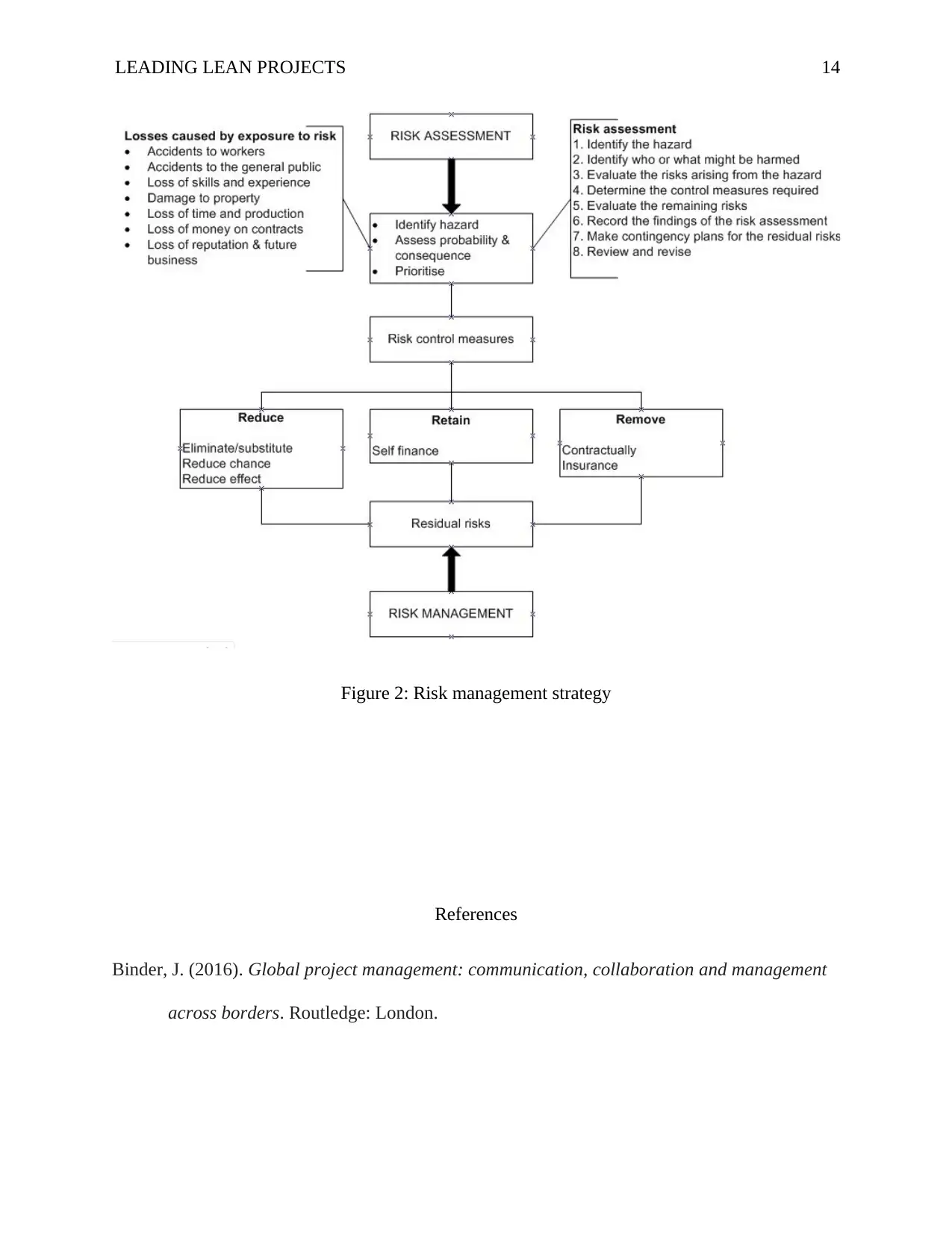
LEADING LEAN PROJECTS 14
Figure 2: Risk management strategy
References
Binder, J. (2016). Global project management: communication, collaboration and management
across borders. Routledge: London.
Figure 2: Risk management strategy
References
Binder, J. (2016). Global project management: communication, collaboration and management
across borders. Routledge: London.
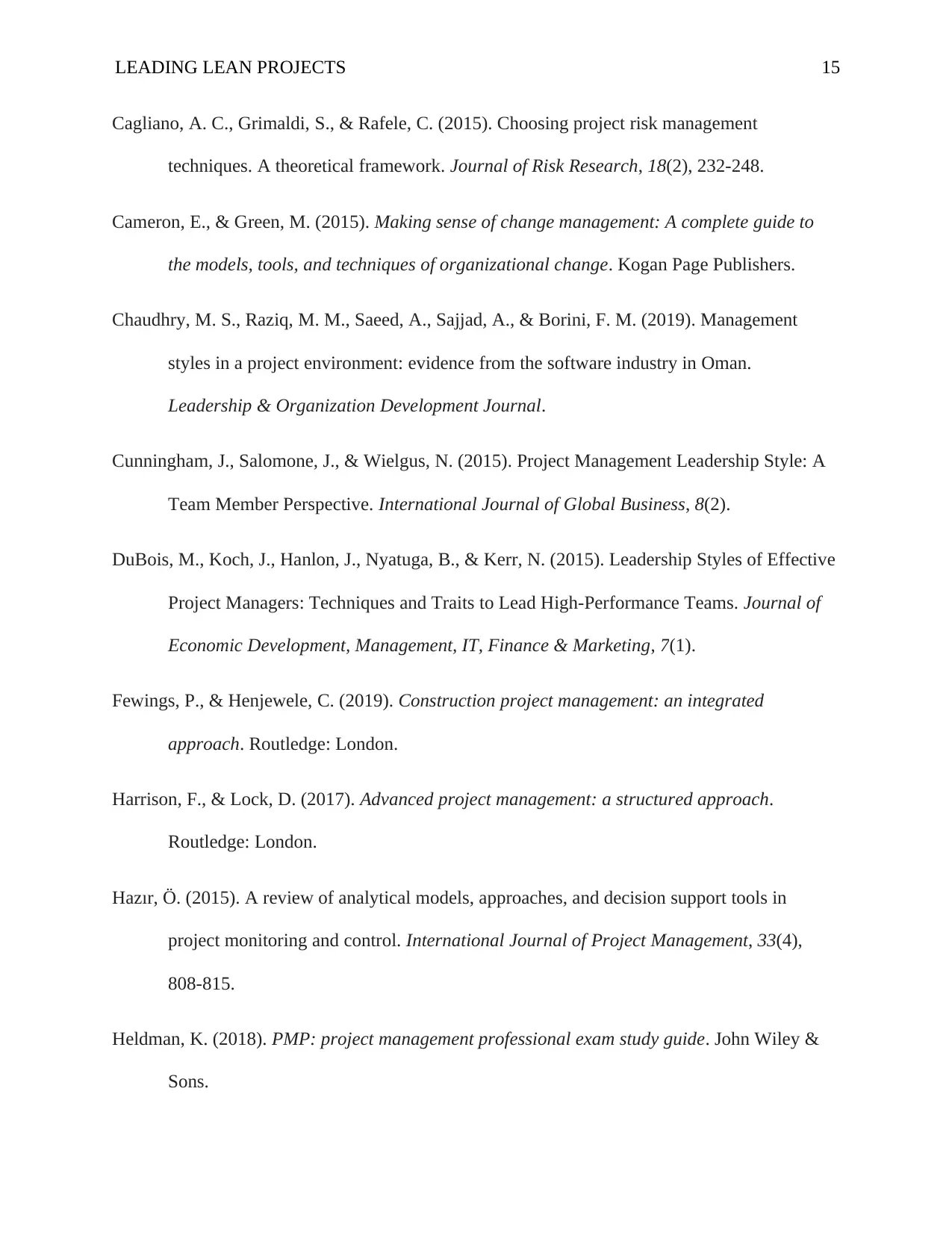
LEADING LEAN PROJECTS 15
Cagliano, A. C., Grimaldi, S., & Rafele, C. (2015). Choosing project risk management
techniques. A theoretical framework. Journal of Risk Research, 18(2), 232-248.
Cameron, E., & Green, M. (2015). Making sense of change management: A complete guide to
the models, tools, and techniques of organizational change. Kogan Page Publishers.
Chaudhry, M. S., Raziq, M. M., Saeed, A., Sajjad, A., & Borini, F. M. (2019). Management
styles in a project environment: evidence from the software industry in Oman.
Leadership & Organization Development Journal.
Cunningham, J., Salomone, J., & Wielgus, N. (2015). Project Management Leadership Style: A
Team Member Perspective. International Journal of Global Business, 8(2).
DuBois, M., Koch, J., Hanlon, J., Nyatuga, B., & Kerr, N. (2015). Leadership Styles of Effective
Project Managers: Techniques and Traits to Lead High-Performance Teams. Journal of
Economic Development, Management, IT, Finance & Marketing, 7(1).
Fewings, P., & Henjewele, C. (2019). Construction project management: an integrated
approach. Routledge: London.
Harrison, F., & Lock, D. (2017). Advanced project management: a structured approach.
Routledge: London.
Hazır, Ö. (2015). A review of analytical models, approaches, and decision support tools in
project monitoring and control. International Journal of Project Management, 33(4),
808-815.
Heldman, K. (2018). PMP: project management professional exam study guide. John Wiley &
Sons.
Cagliano, A. C., Grimaldi, S., & Rafele, C. (2015). Choosing project risk management
techniques. A theoretical framework. Journal of Risk Research, 18(2), 232-248.
Cameron, E., & Green, M. (2015). Making sense of change management: A complete guide to
the models, tools, and techniques of organizational change. Kogan Page Publishers.
Chaudhry, M. S., Raziq, M. M., Saeed, A., Sajjad, A., & Borini, F. M. (2019). Management
styles in a project environment: evidence from the software industry in Oman.
Leadership & Organization Development Journal.
Cunningham, J., Salomone, J., & Wielgus, N. (2015). Project Management Leadership Style: A
Team Member Perspective. International Journal of Global Business, 8(2).
DuBois, M., Koch, J., Hanlon, J., Nyatuga, B., & Kerr, N. (2015). Leadership Styles of Effective
Project Managers: Techniques and Traits to Lead High-Performance Teams. Journal of
Economic Development, Management, IT, Finance & Marketing, 7(1).
Fewings, P., & Henjewele, C. (2019). Construction project management: an integrated
approach. Routledge: London.
Harrison, F., & Lock, D. (2017). Advanced project management: a structured approach.
Routledge: London.
Hazır, Ö. (2015). A review of analytical models, approaches, and decision support tools in
project monitoring and control. International Journal of Project Management, 33(4),
808-815.
Heldman, K. (2018). PMP: project management professional exam study guide. John Wiley &
Sons.
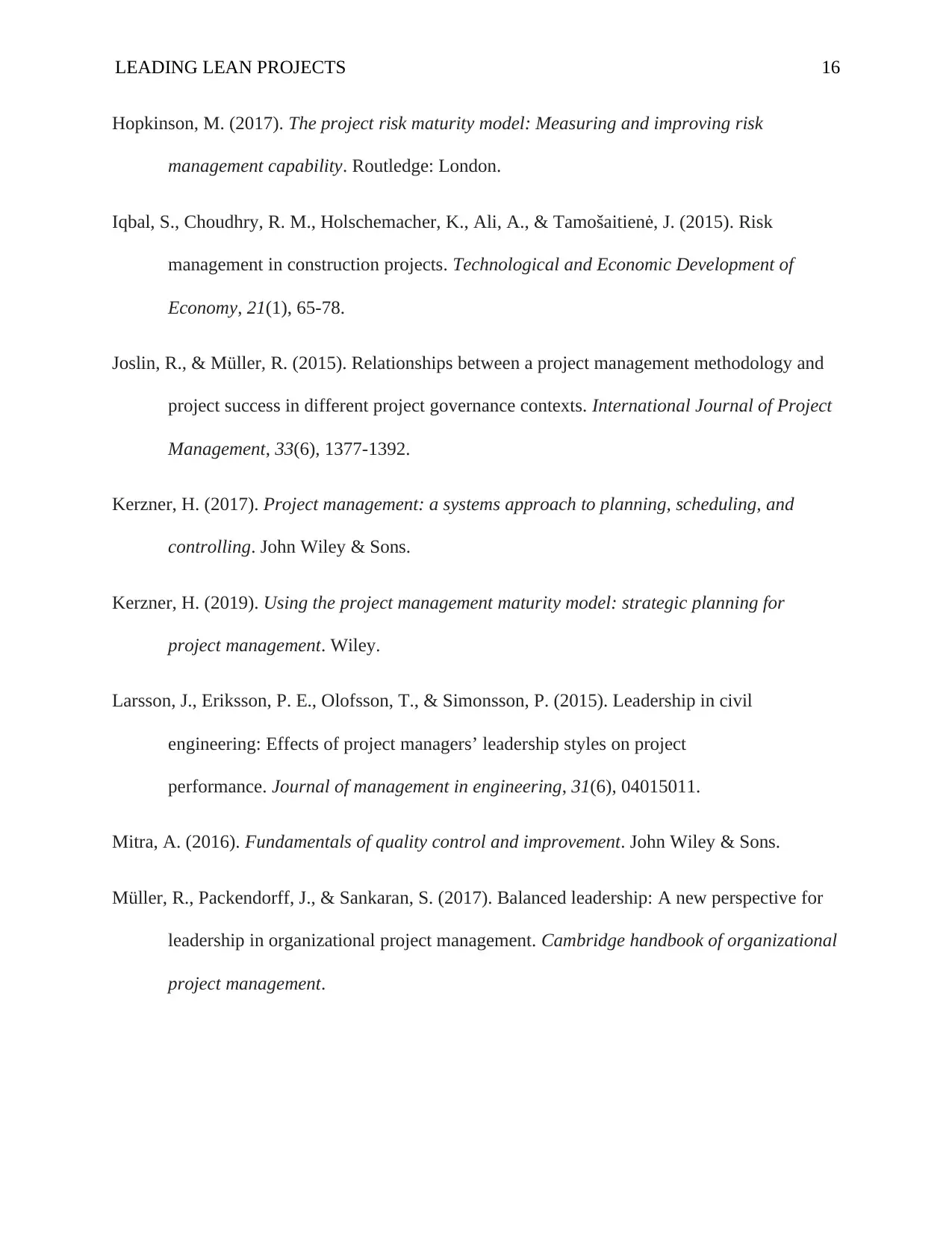
LEADING LEAN PROJECTS 16
Hopkinson, M. (2017). The project risk maturity model: Measuring and improving risk
management capability. Routledge: London.
Iqbal, S., Choudhry, R. M., Holschemacher, K., Ali, A., & Tamošaitienė, J. (2015). Risk
management in construction projects. Technological and Economic Development of
Economy, 21(1), 65-78.
Joslin, R., & Müller, R. (2015). Relationships between a project management methodology and
project success in different project governance contexts. International Journal of Project
Management, 33(6), 1377-1392.
Kerzner, H. (2017). Project management: a systems approach to planning, scheduling, and
controlling. John Wiley & Sons.
Kerzner, H. (2019). Using the project management maturity model: strategic planning for
project management. Wiley.
Larsson, J., Eriksson, P. E., Olofsson, T., & Simonsson, P. (2015). Leadership in civil
engineering: Effects of project managers’ leadership styles on project
performance. Journal of management in engineering, 31(6), 04015011.
Mitra, A. (2016). Fundamentals of quality control and improvement. John Wiley & Sons.
Müller, R., Packendorff, J., & Sankaran, S. (2017). Balanced leadership: A new perspective for
leadership in organizational project management. Cambridge handbook of organizational
project management.
Hopkinson, M. (2017). The project risk maturity model: Measuring and improving risk
management capability. Routledge: London.
Iqbal, S., Choudhry, R. M., Holschemacher, K., Ali, A., & Tamošaitienė, J. (2015). Risk
management in construction projects. Technological and Economic Development of
Economy, 21(1), 65-78.
Joslin, R., & Müller, R. (2015). Relationships between a project management methodology and
project success in different project governance contexts. International Journal of Project
Management, 33(6), 1377-1392.
Kerzner, H. (2017). Project management: a systems approach to planning, scheduling, and
controlling. John Wiley & Sons.
Kerzner, H. (2019). Using the project management maturity model: strategic planning for
project management. Wiley.
Larsson, J., Eriksson, P. E., Olofsson, T., & Simonsson, P. (2015). Leadership in civil
engineering: Effects of project managers’ leadership styles on project
performance. Journal of management in engineering, 31(6), 04015011.
Mitra, A. (2016). Fundamentals of quality control and improvement. John Wiley & Sons.
Müller, R., Packendorff, J., & Sankaran, S. (2017). Balanced leadership: A new perspective for
leadership in organizational project management. Cambridge handbook of organizational
project management.
Secure Best Marks with AI Grader
Need help grading? Try our AI Grader for instant feedback on your assignments.
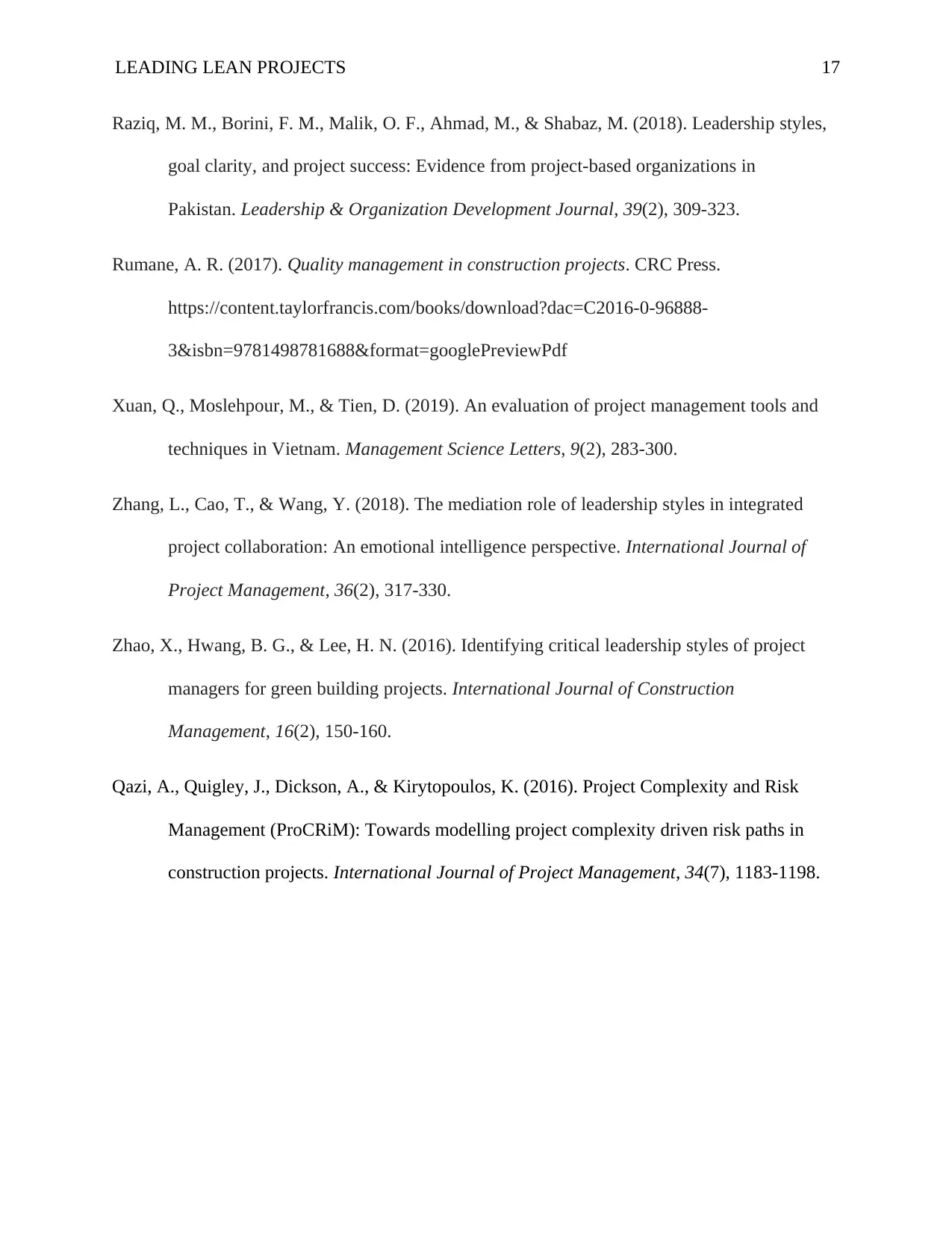
LEADING LEAN PROJECTS 17
Raziq, M. M., Borini, F. M., Malik, O. F., Ahmad, M., & Shabaz, M. (2018). Leadership styles,
goal clarity, and project success: Evidence from project-based organizations in
Pakistan. Leadership & Organization Development Journal, 39(2), 309-323.
Rumane, A. R. (2017). Quality management in construction projects. CRC Press.
https://content.taylorfrancis.com/books/download?dac=C2016-0-96888-
3&isbn=9781498781688&format=googlePreviewPdf
Xuan, Q., Moslehpour, M., & Tien, D. (2019). An evaluation of project management tools and
techniques in Vietnam. Management Science Letters, 9(2), 283-300.
Zhang, L., Cao, T., & Wang, Y. (2018). The mediation role of leadership styles in integrated
project collaboration: An emotional intelligence perspective. International Journal of
Project Management, 36(2), 317-330.
Zhao, X., Hwang, B. G., & Lee, H. N. (2016). Identifying critical leadership styles of project
managers for green building projects. International Journal of Construction
Management, 16(2), 150-160.
Qazi, A., Quigley, J., Dickson, A., & Kirytopoulos, K. (2016). Project Complexity and Risk
Management (ProCRiM): Towards modelling project complexity driven risk paths in
construction projects. International Journal of Project Management, 34(7), 1183-1198.
Raziq, M. M., Borini, F. M., Malik, O. F., Ahmad, M., & Shabaz, M. (2018). Leadership styles,
goal clarity, and project success: Evidence from project-based organizations in
Pakistan. Leadership & Organization Development Journal, 39(2), 309-323.
Rumane, A. R. (2017). Quality management in construction projects. CRC Press.
https://content.taylorfrancis.com/books/download?dac=C2016-0-96888-
3&isbn=9781498781688&format=googlePreviewPdf
Xuan, Q., Moslehpour, M., & Tien, D. (2019). An evaluation of project management tools and
techniques in Vietnam. Management Science Letters, 9(2), 283-300.
Zhang, L., Cao, T., & Wang, Y. (2018). The mediation role of leadership styles in integrated
project collaboration: An emotional intelligence perspective. International Journal of
Project Management, 36(2), 317-330.
Zhao, X., Hwang, B. G., & Lee, H. N. (2016). Identifying critical leadership styles of project
managers for green building projects. International Journal of Construction
Management, 16(2), 150-160.
Qazi, A., Quigley, J., Dickson, A., & Kirytopoulos, K. (2016). Project Complexity and Risk
Management (ProCRiM): Towards modelling project complexity driven risk paths in
construction projects. International Journal of Project Management, 34(7), 1183-1198.
1 out of 17
Your All-in-One AI-Powered Toolkit for Academic Success.
+13062052269
info@desklib.com
Available 24*7 on WhatsApp / Email
![[object Object]](/_next/static/media/star-bottom.7253800d.svg)
Unlock your academic potential
© 2024 | Zucol Services PVT LTD | All rights reserved.
